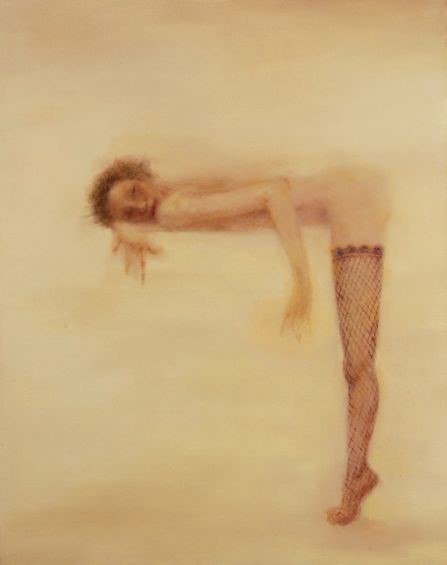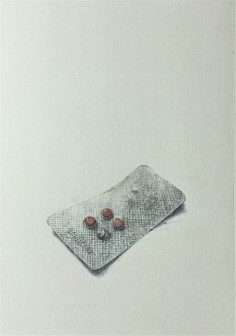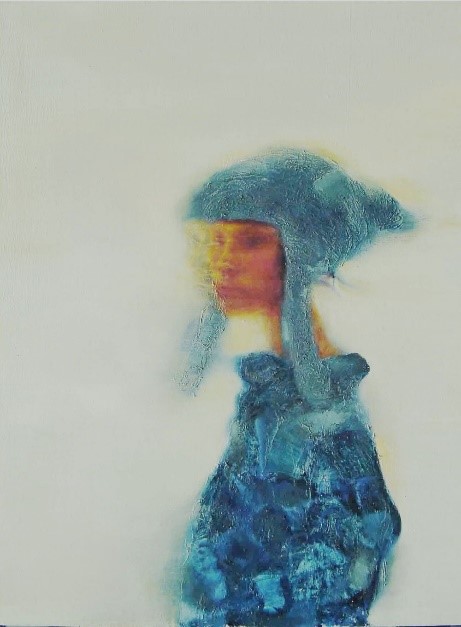This article is based on an interview that I conducted in October 2019 with a female Chinese contemporary artist residing in Oslo. Through her unique and heartfelt narrative, I aim to present how she understands and relates to expression, creative freedom and contemporary art in general.
On a mission to gather interview-data for my master’s thesis, I visited GalleriF48, near Frognerparken, where I met with artist Xia Hua (夏华), or ‘Summer’ as she asked to be called. Summer has lived in Norway for ten years and owns and runs the gallery wherein she exhibits her own and other artists’ works. She was born in a small village in the Yunnan Province, southwest China. During the years 1991-1995 and 2000-2007, she studied art, and eventually became an art teacher, at Fine Art University in Chongqing. These were important years in her artist career and many of her painting series were created during this period. In 2008 she moved to Norway and started a whole new chapter in her life.

“It wasn’t easy coming to a whole new country. I didn’t know the language or the culture. I was an immigrant, and since I wasn’t a recognized artist in my new environment, I had difficulties advancing my career. I soon realized I had to change the way I thought about art. Before, I had focused a lot on techniques, I guess that’s typically Chinese, but then I started focusing more on concepts instead. It wasn’t easy to make this mental transition, but when I did, I found myself communicating better with the people around me. It was as if I had learned a new language. Even though I didn’t understand Norwegian, and my English at the time was very poor, I could now speak the universal language of Art”.
The complexity of Contemporary art
Summer describes herself as a continuously evolving artist. She enjoys trying new materials, techniques and forms of expression. Her homepage (www.xiahua.no) contains demonstrations of oil-, acrylic-, and aquarelle paintings, as well as mixed media installations. She sees herself as a contemporary or modern artist but emphasizes that artists should always try to explore new impressions and expressions.
“The choices of materials and techniques may differ from artist to artist, but that’s not the most important thing. What’s most important is the concepts – the messages behind the expressions. To have a concept involves focusing on one specific thing”.
For those not familiar with contemporary art, an oversimplified description could be that it is a category of art which focuses on presenting the present. It does so not by neglecting the past or the future, but by including itself in certain contemporary contexts through different mediums. A common misunderstanding may be that contemporary art is essentially political. Although there are many examples in which such a description could be accurate, there are also plenty where that is not the case at all. The framework of contemporary art includes various different focuses and art forms, such as moving pictures, paintings, dance, photography, sculpture, performance art, installations, and so forth. The connections between concepts, contexts and expressions are essential and may vary significantly between each artist, which makes contemporary art an extremely diverse art genre. To use the phrasing “Chinese contemporary art” can therefore be a bit misleading as it may indicate that contemporary art has different characteristics related to specific geographic or cultural contexts, but due to the genre’s diverse nature, such a generalization appears problematic. During my interview with Summer, she suggested that even though several frequently mentioned characteristics may collectively compose a somewhat fixed definition of contemporary art, the interpretation of such a definition may still vary from place to place and between individuals.
“‘Contemporary art’ may mean one thing in one city and a whole other thing in the neighboring city. There’s really no such thing as a typical ‘Chinese contemporary artist’, nor a typical ‘Norwegian contemporary artist’. These words may disclose where the artist is from, but they don’t say anything about the artist’s individual style or expression”.
The significance of concepts and memories
Although Summer claims she has evolved a lot as an artist since she moved to Norway, her sources of inspiration remain somewhat the same. She regards the story behind the expression as extremely important. According to her, regardless of cultural background, people’s lives are deeply influenced by emotions, memories and ideas about love, lust, fear and loneliness.
“Many other contemporary artists focus on socio-political issues, such as the climate crisis, refugees or democracy. For me, art is more like personal therapy. A lot of what I do is based on feelings and memories that comes from within me. I’m very cognitive in that sense. Everything I’ve been through has led me to this point in life, and I am the person I am today because of those experiences. When I was young, I often experienced being left alone by my parents and I felt rather lonely and afraid of people and the environment around me. However, when I started to study art, I became more confident and ended up enjoying my alone-time”.
Summer explained how valuable her memories are to her, and how she often works to keep these memories alive through her art. She somewhat sees it as a way of honoring these memories whilst she still has them, as she is certain that they will disappear one day.
“I realized very early that everything in my life – the people I met, including my family, my love, good or bad memories, events, and so on – would eventually disappear. But even though I knew it might bring me sadness or regret, I’ve never feared this process of ‘fading away’. All I can do is try to record those memories in my artistic way, which can be through an either clear and concrete, or abstract and ‘fuzzy’, expression”.

In one of Summer’s watercolor series from 2017, memories are her sources of inspiration. On Chinese handicraft’s rice paper, she has used her memory to paint different every-day items from her home. Overall, Summer accepts and embraces the idea of time moving forward and memories fading. As she continues her slow, yet fulfilling, artistic journey, the path before her becomes clearer and she is looking brightly upon the future.
On the topic of freedom and success in China and Norway
When discussing ‘freedom’ in the setting of Chinese art, many may immediately draw associations to art censorships, policies and freedom of expression. However, when I asked Summer whether she felt free to express herself however she wanted in her work, she offered me a different perspective on freedom. She explained that she greatly appreciates and admires artists who are concerned with public themes in contemporary society and political life, and she believes that the notion of freedom mainly depends on socio-political, cultural and legal premises. However, she does not see herself as a typically “political” artist, and, to her, there is another important dimension to the concept of freedom which involves how one may interpret it in relation to one’s own, individual life. For her, freedom is closely related to mastering different techniques and languages. It is first when she reaches the point where she no longer feels limited by technical skills, but is able to communicate her ideas and concepts with ultimate ease, that she feels truly free in her expression.
“After we’ve mastered the techniques sufficiently, we do no longer have to be trapped by them. When we can forget about the technical aspect of creating, we become truly free in our creative process. And the same goes for learning languages. A specific artistic language may transcend Chinese, Norwegian, or English. Yet, I have to say that being able to communicate in for instance Norwegian, also provides me with a great sense of freedom in my life”.
During the interview, it became clear that Summer regards the concept of freedom as a positive aspect within her creative process. She explained that by seeing art as a language, she feels freer to express herself however she wants, without ever having to doubt or sensor herself in her work. She feels that in Norway, one may talk openly about important topics such as politics, equality and identity. The only real limitation on expression she can think of is her reluctance towards mimicking other artists. Summer suggests that artists should follow their own individual path, and that if one would be willing to change one’s expression, for instance for the sake of making money, one would become less “true” towards the art. As we moved on to talk about creative freedom in China, she presented me with a dilemma related to recent developments within the Chinese art scene.
“Contemporary art hasn’t been around in China for very long, and it’s taken some time for the Chinese population and government to understand and appreciate it. However, judging from domestic media reports in the past two years, we can see that newly established public art museums, art centers and private museums are constantly popping up in many Chinese cities. There has also been a large increase in art exhibitions and events. This development is amazing compared to ten years ago when I lived in China, and I hope it may lead to a healthy environment wherein art students and artists will have more opportunities and support.
However, there are still many topics in China that are taboo. A lot of it has to do with the transparency of the media still being extremely limited. Furthermore, various new polices have recently been introduced in the country. These policies are related to film production, literary works, visual arts and music. The policies have led to clear restrictions regarding public topics such as politics, religion, homosexuality, drug abuse, etc. This contradictory development constitutes a real dilemma for many artists in China. On one hand, the state continues to allocate more resources to culture and art, whilst on the other hand the rules and restrictions are becoming increasingly strict”.
Since the commercial and modern art gallery GalleriF48 was established in 2017, Summer has collaborated with various painters, photographers and designers. She enjoys the privilege to choose what artists she wants to work with, and what artworks to put on display. However, she also points out that the gallery is still in its infancy, the audience is still random, and the Oslo city art market is fairly limited.
“When I make choices regarding exhibitions, I rely a lot on my own artistic sense and feelings, but I also have to consider the tastes of the audiences. The quality of the art always comes first, and whether the artist is young, old, well-known or newly established is less important to me. There are several European artists that I would love to represent in my gallery, but their works are usually more suitable for larger exhibition spaces. In addition, the costs for such investments and operations are much too high for a small gallery such as mine”.
A brief artwork analysis
As art is a major part of Summer’s communicative tool set, I saw fit to end this article with a brief analysis of one of her paintings. With her personal style in mind, the analysis focuses less on the painting’s formal elements, and more on its context and symbolism.

The painting is a 41x32 cm large aquarelle painting from the series “Puster”, or “Breathing” (2016). The motif is of a naked woman, surrounded by black water, cradling a baby. She seems to be standing on the bottom, with her head breaking through the water surface, looking slightly up towards the bright sky above. The woman’s face is a clear focal point, and the bright orange and white colors surrounding it sort of blend together and transcribe almost as a halo. It is difficult not to draw parallels to the virgin Mary as she is often depicted in similar compositions with the baby Jesus. The variety in color in the painting is rather limited, including different nuances of orange, black, white and grey. Vertically, approximately nine tenths of the space is relatively dark, and, perhaps due to the chaotic brush patterns, comes off as a bit unnerving. Yet, the woman’s posture, and brightness around her head, sends a contradictive message of calmness and comfort. The strong contrasts between white, orange and pitch black within the water surface creates a mirroring effect. It also creates a clear division between the pale, yet warm, tones in the sky above and the fussy mass of grayscale displayed below.
On her homepage, Summer has provided an explanation to what inspired her to paint the series. It is based upon reflections on her childhood in China. The nation’s sever water pollution-problems, together with a personal, instinctual fear of water, made her feel as if she was being choked. As an adult, and parent, Summer managed to escape those unpleasant feelings and instead learned how to cope with them – to “breathe under water”. She describes the finishing of the series as a mile-stone in her personal development, wherein she was finally able to let go of some dark memories. By recreating such memories through her art, she experiences a sense of healing. Overall, I find this painting to be a good representation of how Summer involves feelings and memories in her artistic process. Moreover, it demonstrates how she often works with contrasts between lightness and darkness, hope and despair, and between past and present. It is not merely a painting, but a story, her story, and she chooses to share it with the world.
Further reading
For further information regarding contemporary art, I can recommend reading Smith (2009), Stallabrass (2004) and Wiseman and Liu (2011). Regarding the politicization of art in China, and art in relation to human rights, I can recommend reading Gladstone (2014, 2016), Groys (2008) and Henders and Cho (2014). I can also recommend visiting Summer’s website www.xiahua.no to learn more about the artist and see the rest of her works.
Gladston, Paul. Contemporary Chinese Art: A Critical History. London: Reaktion Books Ltd, 2014.
Gladston, Paul. Deconstructing Contemporary Chinese Art: Selected Critical Writings and Conversations, 2007-2014. 1st ed. 2016. ed., Springer Berlin Heidelberg: Imprint: Springer, 2016.
Groys, Boris. “The Topology of Contemporary Art.” Antinomies of Art and Culture: Modernity, Postmodernity, Contemporaneity. Ed. Terry Smith., et al. Duke University Press, 2008, pp. 71-80.
Henders, Susan J., Lily Cho, and Michael Bodden. Human Rights and the Arts: Perspectives on Global Asia. Global Encounters. Lanham, Maryland: Lexington Books, 2014.
Smith, Terry. What Is Contemporary Art?. Chicago: The University of Chicago Press, 2009.
Stallabrass, Julian. Contemporary art: A very short introduction. New York: Oxford University Press, 2004.
Wiseman, Mary Bittner., and Yuedi Liu. Subversive Strategies in Contemporary Chinese Art. Vol. V. 31. Philosophy of History and Culture: Leiden, Brill, 2011.
About Annica Marie Fosli

Originally from Sweden, Annica Marie Fosli is studying “Chinese Society and Politics” in UiO’s master program “Asia and Middle East Studies”. Her main academic interests include Chinese society, language, culture and art. She is currently studying how different topics related to Chinese culture and society may be reflected through Chinese visual contemporary art and artists’ narratives.
